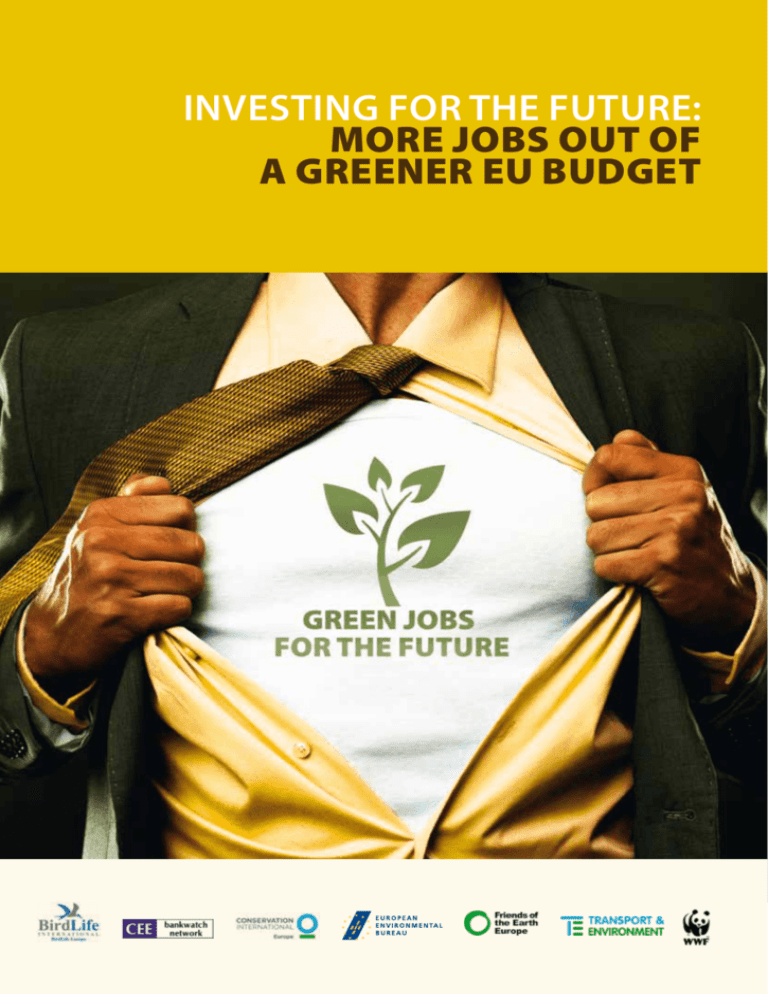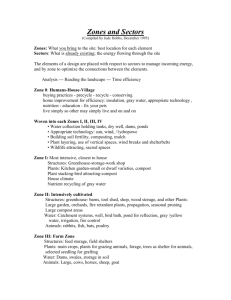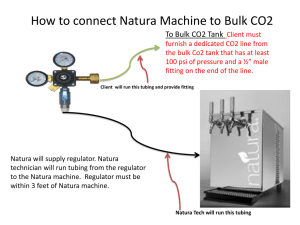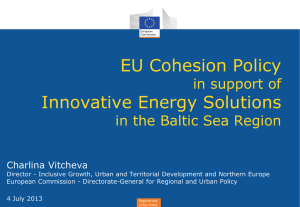JOBS OUT OF A GREENER EU BUDGET
advertisement

Investing for the future: More jobs out of a greener Eu budget The Benefits OF Investing in Green Sectors The next European Budget (2014-2020) is being decided in troubled times when we are faced with a triple crisis – the environmental, the social and the economic crisis. But such difficult timing also constitutes an opportunity: if smartly used, the next EU Budget can help Europe improve its economic stability and create more jobs in a period of rising unemployment while at the same time reducing its unsustainable ecological footprint. Environmental sustainability and economic prosperity are not conflicting. Several influential research efforts, such as UNEP’s Green Economy Report published in February 2011, have shown that greening of economies ultimately brings about positive economic impacts. The European Commission, both in its proposal for the next EU Budget 2014-2020 and in the Europe 2020 Strategy, has clearly highlighted the importance and the feasibility of linking climate, energy, natural resources and employment policies to help deliver a brighter future for the EU’s people, economy and environment. 1 http://www.ghkint.com/ ·2· Within this context, a coalition of environmental NGOs commissioned a report ‘Evaluating the Potential for Green Jobs in the next Multi-annual Financial Framework’ to GHK consultancy1 with the aim of revealing the potential contribution that ‘greening’ the EU Budget could bring to employment. This study reveals that investing in green sectors brings about positive employment benefits. In addition, these benefits gradually increase with the improvement in the long-term sustainability of economic activity that follows the initial investment. While the study focuses on the potential for job creation, greening the EU’s economy contributes to protection and enhancement of the environment and provides other socio-economic benefits, notably an increase in the quality of life of European citizens. Furthermore, the economic benefits provided by ecosystem services such as climate regulation and the provision of resources, such as clean water, as well as long-term food security, can be significant and must be taken into account in policy decisions related to the EU Budget. SUMMARY OF MAIN CONCLUSIONS OF THE STUDY 1. Environmental sustainability and economic prosperity go hand in hand; 2. Despite employment being a key policy goal of the EU, the European Commission has not estimated how many jobs it expects its €1 trillion budget to create by 2020; 3. Investing in a green EU Budget creates more jobs than the current EU Budget. Furthermore, a sustainable economy produces long term employment with gradually increasing benefits; © Ernie Janes, (rspb-images.com) 4. Both land based green activities such as management of Natura 2000 sites and sustainable infrastructure activities such as renewable energies have a higher job impact than the current Common Agricultural Policy and Cohesion Policy. How many jobs are provided with the current investments? There are fundamental information gaps that hamper the development of an EU Budget that follows the smart, sustainable and inclusive imperative of the EU 2020 Strategy. © David Kjaer, (rspb-images.com) The EU has never estimated how many jobs are created, or are intended to be created, by its €1 trillion budget, neither through the Common Agricultural Policy nor the Cohesion Policy. Furthermore, member states’national budgets do not include adequate data. This lack of information underlines the incoherence of EU promises and makes it impossible to gauge the real impact of current and the proposed budgetary investments. It is essential to gather good evidence to allow reliable information for the potential for job creation through investment in the green sector. How, then, can citizens assess whether the EU is indeed fulfilling its job promises, and which part of this promise should be reached by spending their taxpayer’s money? We believe that the results of this study can help to start answering this question. ·3· KEY FINDINGS OF THE STUDY The study estimates the potential for jobs created through an investment of €1 billion in several green sectors and compares this with the number of jobs created through two key current EU policies: the Cohesion Policy and the Common Agricultural Policy (CAP). These two funds are the largest of the EU Budget and account for over two thirds of the total. The estimates have been made by GHK consultancy based on a review of the literature.2 Figure 1 illustrates the job potential within four green sectors (Renewable Energies, Conservation/Natura 2000, Energy Savings, and Sustainable Transport) and the main types of jobs that contribute to this job potential. Job potential per €1 billion investment from the EU Budget A study by the European Commission6, while not actually quantifying the job impact of different CAP subsidies, has estimated that completely abolishing the CAP would lead to a decrease of around 1-2 % of EU agricultural workforce. This corresponds to job The total jobs created/sustained in a green budget € 1.35 € 13.82 € 4.5 € 3.85 Figure 2: The amount of jobs created is based on the direct investment (billion €) within these sectors sources from the supporting EU funds Renewable Energies jobs created EU Budget investment (supported by Cohesion Policy) Conservation/Natura 2000 jobs created EU Budget investment (supported by Cohesion Policy, CAP, LIFE programme, EMFF5) Energy Savings in buildings jobs created EU Budget investment (supported by Cohesion Policy) Figure 1: The total amount of jobs mainly includes direct jobs and some sectors of indirect and induced jobs.3 Sustainable Transport jobs created EU Budget investment (supported by Cohesion Policy, Sustainable Transport - Railway construction and maintenance; Upstream supplies (raw materials, design) Energy Savings in Buildings - Construction Conservation/Natura 2000 - Installations and land management Renewable Energies - Production and installation; Upstream supplies (machines and raw materials) Connecting Europe Facility) The potential for jobs to be created/ sustained from investing in these sectors is significant especially when analysing this potential within a “green budget” as proposed by environmental NGOs 4 (Figure 2). losses of 3,000 to 6,000 full time equivalent jobs per €1 billion expenditure of the current CAP. Based on DG REGIO data from Operational Programmes, Eurostat data and GHK consultancy estimates, the Cohesion Policy job impact currently represents approximately 16,800 full time equivalent jobs supported per €1 billion of Cohesion Policy. 2 Surprisingly, despite the significance of employment as a policy goal, it has not been possible to identify any quantified analysis of the job creation triggered by current EU funds, together or by individual fund. Therefore, the job impact of the Common Agriculture Policy (CAP) and of the Cohesion Policy has been estimated. 3 Direct jobs are contributed by financing the green sector; Indirect jobs can be from sectors supplying goods and services to the financed green sector; Indirect jobs can also be from the impact on the demand of other sectors due to the financing of the green sector; Induced jobs can be from sectors impacted due to changes in wages and income of households as a result of financing of the green sector. 4 The numbers used are based on a green budget that has been proposed by WWF in the publication: WWF (2011), Unlocking the Potential of the EU Budget – Financing a greener and more inclusive economy - Volume 2 Intelligent investments 5 European Maritime Fisheries Fund 6 Eurostat, Scenar2020, DG Agri, 2006. http://ec.europa.eu/agriculture/agrista/2006/scenar2020/final_report/scenar2020final.pdf ·4· Comparing job creation between the current policy and a green budget Estimated yearly investment from the EU Budget 2007-2013 in key policies Fund Recommended yearly investment from the EU Budget 2014-2020 in key policies % Efficiency Gain of redirecting funds to green sectors in job terms % of the EU Budget Jobs created/ sustained (estimate) Proposed % to be dedicated to specific green sectors Jobs created/ sustained (estimate) in green sectors7 Cohesion Policy 35,72% 836,640 12,84% 461,736 CAP 41,97% 351,000 1,30% 55,100 483% Total 77,69 1.187,640 14,28% 516,836 320% 146% Figure 3: Yearly jobs created/sustained under the current Cohesion Policy and CAP (amounting 78% of the total EU Budget 2007-2013) and under a future Cohesion Policy and CAP supporting green sectors with an investment of around 14% of the total EU Budget 2014-2020. If a “green budget” were realised from the next MFF 2014-2020, with only 14% of the total EU Budget (a yearly investment of €14.75 billion, based on current Commission proposals), these four sectors could create/sustain more than half a million jobs (Figure 3). In comparison, currently the CAP and the Cohesion Policy, making up about 78% of the current budget (€140 billion per year) only create/sustain a bit more than double of that amount. This suggests that shifting investment from current patterns of investment within the Cohesion Policy and the CAP to green sectors would increase job creation per euro by a factor of three (320%). The employment impact of both land based green activities and sustainable infrastructure activities is higher than that achieved through the current CAP and Cohesion Policy (Figure 4). The amount needed to create one job is much lower in green sectors compared to the current policies. Although more in-depth studies would be valuable, the research suggests that the shift of the EU budget towards green activities will generate a net increase of employment. The employment benefit is even greater if the long-term perspective is taken into account: reducing environmental risks and investing in environmental improvements has economic and employment benefits – the widely respected Stern Review8 (on the costs of climate change) demonstrated the economic benefits of early investment. The TEEB (The Economics of Ecosystems and Biodiversity)9 has revealed a similar picture, provided investments are made towards sustaining ecosystem services and biodiversity. Studies have illustrated that policy inaction to halt the loss of biodiversity will cost the EU more than €1 trillion per year.10 By investing on the long-term perspective, the EU can help create economical stability which in turn creates/sustains employment. The cost of creating one job Figure 4: Amount, in Euros, required from the EU Budget to create one job within the current CAP and Cohesion Policy, and green sectors Current Common Agricultural Policy (CAP) Current Cohesion Policy Sustainable Transport Energy Savings in Buildings Conservation/Natura 2000 Renewable Energies 7 According to the European Commission proposed Budget for ‘Economic, Social and Territorial Cohesion’ (excluding Connecting Europe Facility) and ‘Agriculture and Rural Development’: EC COM(2011) 500 final Part II 8 http://webarchive.nationalarchives.gov.uk/+/http://www.hm-treasury.gov.uk/stern_review_report.htm 9 http://www.teebweb.org/Home/tabid/924/Default.aspx 10 European Commission: Braat, L and Ten Brink P. (2008) Cost of policy inaction (COPI): The case of not meeting the 2010 biodiversity target. ·5· Why invest in these sectors 1.Renewable energies © Andy Hay, (rdpb-images.com) Sustainable solar, wind, hydro and, to a much lesser extent, biomass will all play an important role in delivering the EU’s future energy needs. Binding targets are already in place for increasing renewable energies by 2020. The renewable energy sector does not require constant public investment to sustain it, but is instead dependent on policy development and implementation. The EU Budget plays a significant role in this sector, for example in establishing a grid system that supports and connects renewable energy and promoting research in other renewable energies that are still suffering from under investment such as tidal and geothermal energy. 3. Energy savings in buildings The EU has set a non-binding 20% target for improving its energy efficiency by 2020.12 Europe’s building stock is responsible for 40% of total energy use (and for 36% of EU CO2 emissions), making it the most important sector to target in the fight against climate change and to address the increasing energy dependency of Europe. Apart from making the energy efficiency target binding for member states, the second most important action to reduce energy consumption in the building sector is to mobilise significant parts of the EU Budget for this purpose. It is important to note that as savings accumulate over time, this leads to a positive employment impact in other sectors over the years. 2. Management of Natura 2000 network The Natura 2000 network is the centrepiece of EU nature and biodiversity policy. Several studies have documented the benefits of investing in this network, underlining the wide range of ecosystem services that are provided such as tourism and recreation, water quality or flood control. Natura 2000 management leads on average to the direct creation of 3 to 5 fulltime equivalent jobs per site, while tourism around sites helps to create one additional job.11 Additional jobs created and sustained through ecosystem services provided by Natura 2000 sites have not been assessed. Although the study has focused on the Natura 2000 4. Sustainable transport Europe relies mainly on carbon intensive transport. Transport contributes 21% of total EU emissions and this figure is rising (+20% between 1990 and 2008). A significant modal shift away from road and aviation towards sustainable transport (e.g. rail, urban public transport systems) and demand management (improved traffic management) is necessary. 11 Gantioler, S., Rayment, M., Bassi, S., Kettunen, M., McConville, A., Landgrebe, R., Gerdes, H. and ten Brink, P., 2010. Costs and Socio-Economic Benefits associated with the Natura 2000 Network; Rayment, M., Pirgmaier, E., De Ceuster, G., Hinterberger F., Kuik, O., Leveson Gower, H., Polzin, C., Varma, A., 2009. The economic benefits of environmental policy. A project under the Framework contract for economic analysis. ENV.G.1/ FRA/2006/0073 - 2nd. FINAL REPORT November 2009. 12 European Energy and Climate Change Package ·6· © Bruna Campos © WWF DE network due to the availability of data, the concept of job creation in nature reserves, regardless of a Natura 2000 status, still applies. Policymakers need to set the conditions to enable a transition of investments from the EU and national budgets into a green economy. In doing so, the EU will be better able to achieve economic stability, by ensuring that green jobs are created and sustained and that the policy challenges of climate change and biodiversity loss are tackled. 1. Cohesion Policy must not be wasted on harmful spending. Redirecting more than 40% of Cohesion Policy to clear priorities benefiting the environment (energy savings and renewable energies, nature and biodiversity, and green infrastructures) in all regions, including convergence regions, would have a significant impact on job creation as these are sectors that are currently underfunded. 2. Agriculture subsidies must be redirected to support public goods where jobs will be sustained; more support to environmental action in the agriculture sector would create more jobs. Greening of direct payments must therefore not be diluted and be compulsory. Rural development funds must be increased and earmarked for environmental payments. 3. Natura 2000 must receive coherent and strategic investments, thereby contributing to job creation with a minimal EU budget spending of €4.5 billion per year. Financing of Natura 2000 must be significant and integrated into the Cohesion Policy, the Common Agricultural Policy and the European Maritime and Fisheries Fund, through the implementation of national financial plans for Natura 2000 (‘Prioritised Action Frameworks’). 4. Infrastructure support must focus on sustainable infrastructure to ensure that jobs in these sectors are sustained over time. Opportunities include decarbonised transport, renewable energies, smart grids and environmentally friendly land planning, based on carbon and biodiversity assessment. 5. Environmental and climate change priorities must be directly supported through bottom-up activities. In doing so, local economies and jobs are supported through direct investment in the local environment. The LIFE programme, the only fund devoted to the environment, must be increased from 0.23% currently to a modest 1% of the EU Budget (€1.4 billion per year). 6. The European Commission must assess the impact of the EU Budget on creation or protection of (sustainable) jobs. ·7· © Niall Benvie (rspb-images.com) POLICY RECOMMENDATIONS recycled paper/ printed on Cyclus print BirdLife Europe BirdLife International is a global Partnership of conservation organisations that strives to conserve birds, their habitats and global biodiversity, working with people towards sustainability in the use of natural resources. The BirdLife Partnership operates in more than 100 countries and territories worldwide. BirdLife Europe is represented in 45 countries in Europe and is active in all EU Member States. BirdLife Europe europe@birdlife.org - http://europe.birdlife.org Published in January 2012 - Design by: www.studiostraid.be - © Stichting BirdLife Europe - Conservation International Conservation International is an organisation with global reach and impact. Building upon a strong foundation of science, partnership and field demonstration, CI empowers societies to responsibly and sustainably care for nature for the well-being of humanity. CI works in more than 40 countries on four continents. CI Europe is the organisation’s new office in charge of policy work at EU level. Based in Brussels, it has a status of Belgian ASBL and started its operations in February 2010. europe@conservation.org - www.conservation.org/europe CEE Bankwatch Network CEE Bankwatch Network is an international environmental NGO with member organisations currently from 12 countries across central and Eastern Europe and CIS region. Our mission is to prevent the environmentally and socially harmful impacts of international financial institutions, including EU funding, and to promote alternative solutions and public participation. main@bankwatch.org - www.bankwatch.org European Environmental Bureau – EEB The EEB is a federation of more than 140 environmental citizens’ organisations based in all EU Member States and most Accession Countries, as well as in a few neighbouring countries. These organisations range from local and national, to European and international. The aim of the EEB is to protect and improve the environment of Europe and to enable the citizens of Europe to play their part in achieving that goal. eeb@eeb.org - www.eeb.org Friends of the Earth Europe Friends of the Earth Europe campaigns for sustainable and just societies and for the protection of the environment, unites more than 30 national organisations with thousands of local groups and is part of the world’s largest grassroots environmental network, Friends of the Earth International. info@foeeurope.org - www.foeeurope.org Transport & Environment T&E is an independent pan-European association with scientific and educational aims, with no party political affiliation and devoid of any profit making motive. T&E’s mission is to promote a policy of transport and accessibility, based on the principles of sustainable development, which minimises negative impacts on the environment and health, use of energy and land and all economic and social costs, maximises safety, and guarantees sufficient access for all. Established in 1990, T&E represents around 50 organisations across Europe, mostly environmental groups and sustainable transport campaigners. info@transportenvironment.org - www.transportenvironment.org World Wild Fund for Nature – WWF WWF is one of the world’s largest and most respected independent conservation organisations, with over 5 million supporters and a global network active in over 100 countries. WWF’s mission is to stop the degradation of the earth’s natural environment and to build a future in which humans live in harmony with nature, by conserving the world’s biological diversity, ensuring that the use of renewable natural resources is sustainable, and promoting the reduction of pollution and wasteful consumption. wwf-epo@wwf.eu - www.wwf.eu This report is based on the study: Daly E., Pieterse M., Medhurst J., Evaluating the potential for Green Jobs in the next Multi-annual Financial Framework, London, GHK, August 2011 and can be downloaded from http://www.birdlife.org/eu/pdfs/Green_Jobs.pdf CEE Bankwatch and Friends of the Earth Europe acknowledge the financial support of the European Climate Foundation. Contact details: Bruna Campos, EU Financial Perspectives Policy Officer / Conservational International - Europe, bruna.campos@birdlife.org Licence DK/11/1 Printed on EU Ecolabel certified paper Copying and graphic paper The European Climate Foundation aims to promote climate and energy policies that greatly reduce Europe’s greenhouse gas emissions and helps Europe play an even stronger international leadership role in mitigating climate change. The RSPB works to protect birds and the environment from the major threats posed by climate change, agricultural intensification, expansion of urban areas and transport infrastructure, and over-exploitation of our seas. This publication is part-financed by the European Union. Sole responsibility lies with the author and the European Commission is not responsible for any use that may be made of the information contained therein.







